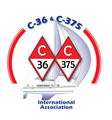Had a longer than expected motor (10 hrs+) and got down to 1/8th of a tank on the fuel gage. High anxiety as I motored up to the fuel dock as I feared every wake that bounced me would cause air to get sucked into the engine. Filled up and it only took 14.5 gals into what is supposedly a 25 gal tank that read 7/8ths empty. I would have expected at least 20 gal's.
Does anyone know if there is an adjustment of any kind on the fuel gage or do I just do a mental calculation each time it gets low? Even though I now know when the gage reads low I still have fuel, its very unsettling.
Chuck Parker
HelenRita 2072 Mk II
2002 Tall Rig - Winged Keel
Atlantic Highlands, NJ

Chuck,
I think that most of the fuel gauges CY uses are a "float arm" type of gauge. They can be adjusted by bending the arm that holds the float (inside the tank), but this method is somewhat trial and error. I found a better way to keep track of fuel is to measure consumption by keeping a maintenance log. Over the 18 years that I owned Julandra (M25XP), the fuel consumption was 0.55 gal/hr. Rather than looking at the fuel gauge, I only looked at the hour meter since last fillup. To be conservative I could figure 0.6 or 0.7, but the numbers were always within a gallon or so. Hope this helps.
Tom Sokoloski
C36/375IA Past Commodore
Noank, CT
Chuck
My fuel gage works very well. That being said I much prefer using Tom's
method of tracking hours. I would never bet my family's safety on the gage.
If you do go to the trouble of fixing the sending unit, I would just replace it. Maybe cleaning the unit might work. It most likely worked when it was new. What changed? I don't think the arm got bent. Maybe the float got a problem? It's a Pain to change. Bending the arm can be a real bit of black art to get it just right.
Chuck Lennox
97 MKii Ventura Ca
Island Girl Hull #1611
I installed a new fuel sensor in my boat, which seemed to work well for one season. This year it accurately read full when I started a cruise, and went to empty in a few short hours. I agree strongly to calculate usage and have a good guess of your fuel status. Being afraid though of inaccuracies, I installed a fuel deck fill in the tank. I made a graph of what I felt were levels of fuel for dead empty to full, and plotted actual refill amounts to check my graph.
Bottom line, you cant beat physically going in and dipping a stick in there. The old fashion methods work well.
Gary Matthesen
"Holiday"
1987 #50646
Oyster Bay Long Island NY
Since the tank does not have a predictable uniform shape and the windings of the sending unit resistor is linear it will never be accurate. I have adjusted mine such that when it shows full - it really is full. This avoids over filling and spilling as it did before. When it shows 1/2 it has used 5 gallons. I am keeping track of the hours and the display and trying to make sense out of it. You can also install an analog volt meter inside to measure the voltage at the sending unit. You can then keep track of at what voltage how many gallons it took to fill. The larger voltage means it is empty. According to my test 8.6 VDC indicates empty and 3.6VDC indicates full.
Sail La Vie 1999 Catalina 36 MKII, M35B-17031, Coyote Point, San Mateo, CA
About Sail La Vie
This sender is linearly very accurate and much less prone to failure than the wire wound swing arm types.
http://www.catalinadirect.com/index.cfm/product/3256/fuel-tank-sending-u...
Nile Schneider
Mañana C36 #1798
Lake Champlain, VT
I installed the new fuel sender along with a new fuel gauge (the old gauge had failed) purchased from Catalina Direct. Not a difficult install on the Mk II. The fuel tank on the MkII is rectangular in shape and lends itself to this type metering very well. Any MkII owners out there who don't trust their fuel gauges should make this improvement.
This new sender/gauge combination is AMAZINGLY ACCURATE. I can predict within a gallon how much fuel I will need to top off. I mentally segment the gauge into 6 US Gallons per quarter, then a glance at the gauge tells me how much I've consumed. I still monitor the gurgling sound and am prepared to cease fueling at the first sign of fuel exiting the vent, and I always run the fuel flow at the slowest possible rate to reduce foaming, but I now have confidence in my fuel gauge that I never had before. In a seaway, the confidence factor reduces and I rely more on a consumption versus time formula, but in protected waters the gauge is very trustworthy.
Larry Brandt
S/V High Flight #2109
Pacific Northwest, PDX-based
2002 C-36 mkII SR/FK M35B
Larry & Nile.... am I correct that, Larry, you changed the gage too because your gage failed but that this sender can be used with the old gage?
Thanks
Chuck Parker
HelenRita 2072 Mk II
2002 Tall Rig - Winged Keel
Atlantic Highlands, NJ
Since the other design kept failing, I finally bought the same as VermontSailor, i.e. http://www.catalinadirect.com/index.cfm/product/3256/fuel-tank-sending-u...
Had it for about a year. Seems fine so far.
Ben Ethridge
Miami, FL
1984 MK1 Hull# 263
Chuck, I changed the sender because I wanted more accuracy and reliability, but I changed the gauge because it had indeed failed. Worth the upgrade, I think.
Larry Brandt
S/V High Flight #2109
Pacific Northwest, PDX-based
2002 C-36 mkII SR/FK M35B